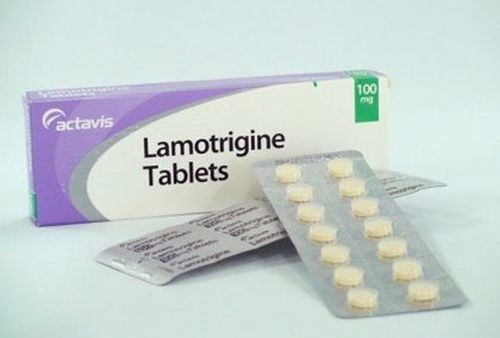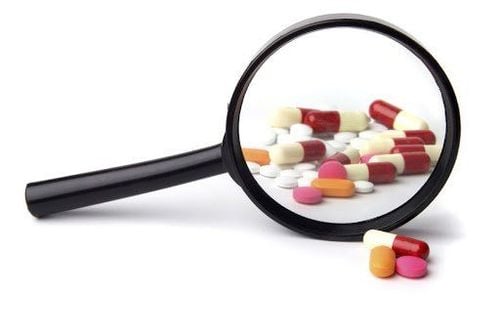This is an automatically translated article.
Lamotrigine is known to be an anticonvulsant, for the treatment of epilepsy, and for the prevention of mood swings in patients with bipolar disorder. For more information about the effects, corresponding doses, as well as any side effects of Lamotrigine, please read the article below.
1. What is lamotrigine?
Lamotrigine belongs to the class of antiepileptic drugs, used alone or in combination with other drugs to treat epileptic seizures in both adults and children. The drug is prepared in many different forms, including:Tablets content of 25 mg, 50 mg, 100 mg, 200 mg. Chewable/dispersible tablets 2 mg, 5 mg, 25 mg, 100 mg. Lamotrigine is also used in adults to delay mood episodes with bipolar disorder (also called mania).
Lamotrigine immediate-release tablets can be used in children under 2 years of age and in combination with certain seizure medications. However, this form of medicine should not be used as a sole medicine in children or adolescents under 16 years of age.
Lamotrigine extended-release tablets are for use in adults and children 13 years of age and older.

Lamotrigine là một loại thuốc chống co giật và điều trị động kinh
2. What are the side effects of lamotrigine?
All drugs can cause side effects. However, many people have no side effects or only mild side effects. While it may be rare, some people can experience very bad and sometimes deadly side effects when taking the drug.
Call your doctor or get medical help if you have any of these or any other side effects that bother you or do not go away.
2.1. Severe skin rash Severe rash such as hives; itchy; red, swollen, blistering, or peeling skin with or without fever; wheeze; chest or throat tightness; trouble breathing, swallowing, or talking; unusual hoarseness; or potentially life-threatening swelling of the mouth, face, lips, tongue, or throat including Stevens-Johnson syndrome and toxic epidermal necrolysis has been reported with the use of immediate-release lamotrigine in humans. adult and pediatric patients.
Discontinue treatment at the first sign of rash (unless the rash is clearly unrelated to the drug).
2.2 Leukocytosis Phagocytosis Lymphocyte phagocytosis (HLH), a rare but potentially life-threatening condition associated with pathological activation of the immune system, has been reported. May occur within days to weeks of taking the drug. If not recognized and treated promptly, HLH can lead to high mortality.
Manifestations include: persistent fever (usually > 38.3°C), rash, hepatosplenomegaly, lymphadenopathy, neurological effects (eg, convulsions, visual disturbances, dyskinesia), leukocytosis, liver dysfunction, high serum ferritin levels, and abnormal coagulation.
If any presentation suggests HLH, evaluate the patient for a possible diagnosis. Discontinue lamotrigine unless an alternative etiology can be identified.
2.3 Multi-organ hypersensitivity Multi-organ hypersensitivity (also known as drug reaction with eosinophilia and systemic symptoms) has been reported; can be fatal or life-threatening. Clinical presentation is variable but often includes fever, rash, and/or lymphadenopathy with involvement of other organ systems (eg, eosinophilia, hepatitis, nephritis, hematologic abnormalities). , myocarditis, myositis).
If multiple organ hypersensitivity is present, the patient should be evaluated immediately. If no alternative cause can be identified, discontinue lamotrigine. Initial manifestations of hypersensitivity (eg, fever, lymphadenopathy) may be present even without a rash.
2.4 Arrhythmia Lamotrigine exhibits class IB antiarrhythmic activity at therapeutically appropriate concentrations.
Increased risk of arrhythmias, including sudden death, in patients with clinically important structural or functional heart disease (i.e. patients with heart failure, valvular heart disease, congenital heart disease, systemic disease) conduction system, ventricular arrhythmia, heart channel disease (eg, Brugada syndrome), clinically important ischemic heart disease, or multiple risk factors for coronary artery disease). Carefully weigh any expected or observed benefit of lamotrigine against the risk of serious arrhythmias and/or death in these patients.
Concomitant use of other sodium channel blockers (eg, carbamazepine, cenobamate, eslicarbazepine, fosphenytoin, lacosamide, oxcarbazepine, phenytoin, rufinamide, topiramate, zonisamide) may further increase the risk of cardiac arrhythmias.
2.5 Hematologic colic neutropenia, leukopenia, anemia, thrombocytopenia, thrombocytopenia, and rarely aplastic anemia and pure red blood cell aplasia have been reported. Such blood disorders may or may not be associated with multi-organ hypersensitivity syndrome (also known as DRESS).
2.6 Risk of Suicide An increased risk of suicide (suicidal ideation or behavior) was observed in an analysis of studies using different anticonvulsant drugs in patients with epilepsy, mental disorders (eg, bipolar disorder, depression, anxiety) and other conditions.
The risk in patients taking anticonvulsants (0.43%) was twice as high as in patients taking placebo (0.24%). An increased risk of suicide was observed 1 week after initiation of anticonvulsant therapy and continued for 24 weeks. The risk is higher for patients with epilepsy than for those receiving anticonvulsants for other conditions.
Closely monitor all patients for changes in behavior that may indicate the emergence or worsening of suicidal thoughts or behavior or depression.
Balance the risk of suicide with the risk of untreated disease. Epilepsy and other conditions treated with anticonvulsants are themselves associated with morbidity and mortality and increased risk of suicide. If suicidal thoughts or behavior occur during anticonvulsant therapy, consider whether these symptoms may be related to the illness itself.

Hãy thông báo các tác dụng phụ của Lamotrigine đến bác sĩ điều trị
Some patients have an underlying diagnosis of systemic lupus erythematosus or other autoimmune diseases. Some patients also have new-onset signs and symptoms involving other organs (primarily the liver and kidneys), which may suggest that aseptic meningitis is part of a hypersensitivity reaction or overall with drugs.
Because of the potential for serious outcomes with untreated meningitis, evaluate patients for other causes and treat appropriately. Discontinue lamotrigine if no other obvious cause of meningitis can be identified.
2.8 Seizures upon discontinuation Abrupt discontinuation of the drug may increase the frequency of seizures, especially in patients with pre-existing seizure disorders; Withdrawal gradually (eg, over a period of ≥2 weeks) and gradually reduce dosage unless safety concerns require more rapid discontinuation.
Status epilepticus
Paroxysmal seizures or therapeutic emergencies have been reported in patients receiving lamotrigine as adjunctive therapy for seizure disorders; The incidence of the disease is difficult to determine precisely.
If a change in seizure control occurs or occurs or side effects become worse, reassess the use and dosage of all anticonvulsants in the regimen.
2.9 Sudden unexplained death in epilepsy Sudden and unexplained death rates reported with immediate-release lamotrigine were higher than would be expected in a healthy population (no have epilepsy); however, incidence is within the estimated range for epileptic patients receiving a chemically unrelated anticonvulsant.
2.10 Binds to Melanin-Rich Tissues Potential accumulation of lamotrigine in melanin-rich tissues (e.g. eyes, pigmented skin) over time, leads to potential toxicity in these tissues with prolonged use long.
The manufacturers make no specific recommendations for routine ophthalmic monitoring; however, clinicians should be aware of possible long-term ophthalmic effects.
2.11 Other side effects of lamotrigine Signs of infection such as fever, chills, very severe sore throat, ear or sinus pain, cough, increased sputum or change in color of sputum, pain when urinating, mouth sores or wounds that do not heal. Signs of liver problems such as dark urine, feeling tired, not hungry, upset stomach or stomach pain, pale stools, vomiting, or yellowing of the skin or eyes. Signs of kidney problems such as an inability to urinate, a change in the amount of urine, blood in the urine, or a lot of weight gain. Shortness of breath, weight gain, or swelling in the arms or legs. Swollen lymph nodes. Very severe muscle pain or weakness. Very severe joint pain or swelling. Any unexplained bruising or bleeding. Feeling very tired or weak. Vision change. Very severe dizziness or fainting. Balance change. Inability to control eye movements. Chest pain or tightness. Flu-like symptoms. Dysmenorrhea Changes in cycles (menstruation). These include spotting or bleeding between cycles.

Đau hoặc tức ngực là một trong các tác dụng phụ khác của thuốc Lamotrigine
3. Some special subjects when using lamotrigine drug
3.1 Pregnant women There are no adequate and well-controlled studies in pregnant women. Data from pregnancy exposure registries and epidemiological studies have not revealed an increased frequency of major birth defects or a consistent pattern of malformations in women exposed to lamotrigine compared with lamotrigine exposure. general population. Much of the data is from women with epilepsy.In animal reproduction studies, developmental toxicity (eg, increased mortality, decreased body weight, increased structural variability, neurobehavioral abnormalities) was observed. closely at clinically relevant doses.
Decreased fetal folate levels in rats, an effect known to be associated with teratogenicity in animals and humans.
Physiological changes during pregnancy may affect lamotrigine plasma concentrations and/or therapeutic efficacy. Adjust dosage to maintain clinical response if necessary.
3.2 Lactating women Lamotrigine plasma concentrations in nursing infants can be as high as 50% of maternal serum concentrations. Neonatal exposure to lamotrigine may be further increased by the immature neonatal glucuronidation required for drug clearance. Apnea, somnolence, and poor feeding have been reported in nursing infants whose mothers are receiving lamotrigine, although it is not known whether these effects are drug-induced.
There are no specific studies on whether lamotrigine can affect milk production. Weigh the known benefits of breastfeeding along with the mother's clinical need for lamotrigine and any potential adverse effects on the nursing infant due to the drug or underlying medical condition.
3.2 Pediatric Use The safety and efficacy of immediate-release formulations of lamotrigine have not been established for the adjunctive treatment of seizure disorders in pediatric patients <2 years of age. The safety and efficacy of immediate-release lamotrigine have not been established for monotherapy in pediatric patients.
Safety and efficacy of extended-release lamotrigine have not been established in children < 13 years of age.
The safety and efficacy of immediate-release lamotrigine in the treatment of bipolar disorder have not been established in pediatric patients <18 years of age.
The rate of severe rash was higher in pediatric patients than in adults receiving lamotrigine.
3.3 Use in geriatrics There is insufficient experience in patients ≥65 years of age to determine whether geriatric patients respond differently or exhibit a different safety profile than younger adults.
3.4 Patients with Hepatic Impairment The initial dose, increment, and maintenance dose are usually reduced by approximately 50% in patients with moderate hepatic impairment (Child-Pugh grade B) and 75% in patients with severe hepatic impairment (Child-Pugh grade B). C). Upgrade and maintenance dose should be adjusted according to clinical response
3.5 Renal impairment Caution should be exercised when Lamictal is administered to patients with renal impairment. For patients with end-stage renal failure, the initial dose of lamotrigine should be based on the patient's concomitant medicinal products; Reduced maintenance dose may be effective in patients with significant renal impairment.
Vinmec International General Hospital is one of the hospitals that not only ensures professional quality with a team of leading medical professionals, modern equipment and technology, but also stands out for its examination and consultation services. comprehensive and professional medical consultation and treatment; civilized, polite, safe and sterile medical examination and treatment space.
Please dial HOTLINE for more information or register for an appointment HERE. Download MyVinmec app to make appointments faster and to manage your bookings easily.













